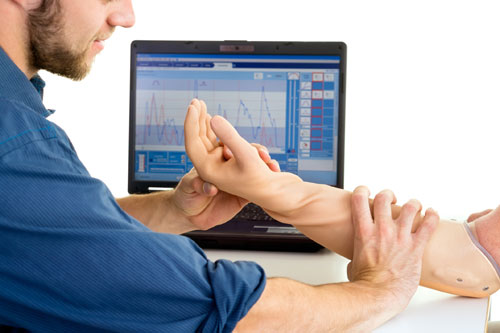Orthotist and Prosthetist Careers
 Orthotists and prosthetists are specialized medical professionals who assess and treat the physical and functional limitations of those suffering from an illness or disability. Orthotists and prosthetists prescribe, design, fit and monitor prostheses and orthoses (artificial devices created to replace a missing part of the body or provide support for injured areas of the body). These devices consist of artificial limbs, braces and other medical or surgical devices.
Orthotists and prosthetists are specialized medical professionals who assess and treat the physical and functional limitations of those suffering from an illness or disability. Orthotists and prosthetists prescribe, design, fit and monitor prostheses and orthoses (artificial devices created to replace a missing part of the body or provide support for injured areas of the body). These devices consist of artificial limbs, braces and other medical or surgical devices.
Orthotists and prosthetists treat a wide range of patients- from babies born with cerebral palsy, to people who have received an amputation following an accident, to elder patients who have lost a limb due to a vascular disease. They also may work in a variety of settings.
Orthotist and Prosthetist Career Snapshot
Typically, an orthotist or prosthetist will meet patients in their own office. These offices may be in major hospitals, private facilities or NGOs. In major hospitals, they will be working as members of an allied health team in the rehabilitation department. Some orthotists and prosthetists also may choose to conduct research for universities and hospitals. Most work full-time and during regular office hours.
Further details on a career as a orthotist and prosthetist are listed below (statistics from the May 2015 Bureau of Labor Statistics and Onet Online):
is the average yearly salary for orthotists and prosthetists.
increase in employment between 2014 and 2024.
have a Post-baccalaureate certificate; 30% have a Bachelor’s degree.
Orthotist/Prosthetist Education
To become an orthotist or prosthetist, one must obtain a bachelor’s degree (preferably in a scientific field) followed by a master’s degree and certification, which usually takes two years to complete. Before the can become certified, they must also complete a residency program.
Orthotist/Prosthetist Job Duties
Orthotists and prosthetists job duties cover the following domains: clinical assessment, patient management, technical implementation, practical management and professional responsibility. They help patients achieve optimum function and prevent further disability by creating and implementing treatment processes that involve the use of orthoses and protheses.
Orthotist/Prosthetist Salaries
As of BLS.gov reports from May 2015, the median annual wage for an orthotist or prosthetist is $64,430, with the lowest 10 percent earning $35,160 and the highest 10 percent earning $107,550. Depending on the type of industry they work in, the salary of orthotists and prosthetists can vary substantially.
Orthotist/Prosthetist Job Outlook
From 2014 to 2024, employment of orthotists and prosthetists is expected to grow by 23 percent. This is a much faster than average growth rate for all occupations; however, due to the fact that this is a very niche occupation, the growth will result in only about 1,900 jobs over the 10 year period. Increase in demand is attributed to the largely aging baby boom population, as diabetes and cardiovascular disease, two leading causes of limb loss, are more common among older people.
Orthotist and Prosthetist Skills & Traits
| Orthotist/Prosthetist Skill Set: | Required Abilities: | Tools Used by Orthotist/Prosthetist: | Typical Work Activities: |
|---|---|---|---|
| • Speaking • Active Listening • Critical Thinking • Reading Comprehension • Service Orientation | • Deductive Reasoning • Inductive Reasoning • Near Vision • Oral Comprehension • Oral Expression | • Cast cutters or saws • Pipe or tube cutter • Power routers • Scanners • Vacuum molding machines | • Getting Information • Caring for Others • Decision Making • Recording Information • Interpersonal Relationships |
Related Careers
Occupational Therapists
Doctorate Degree
Physical Therapists
Doctorate Degree
Respiratory Therapists
Doctorate Degree


